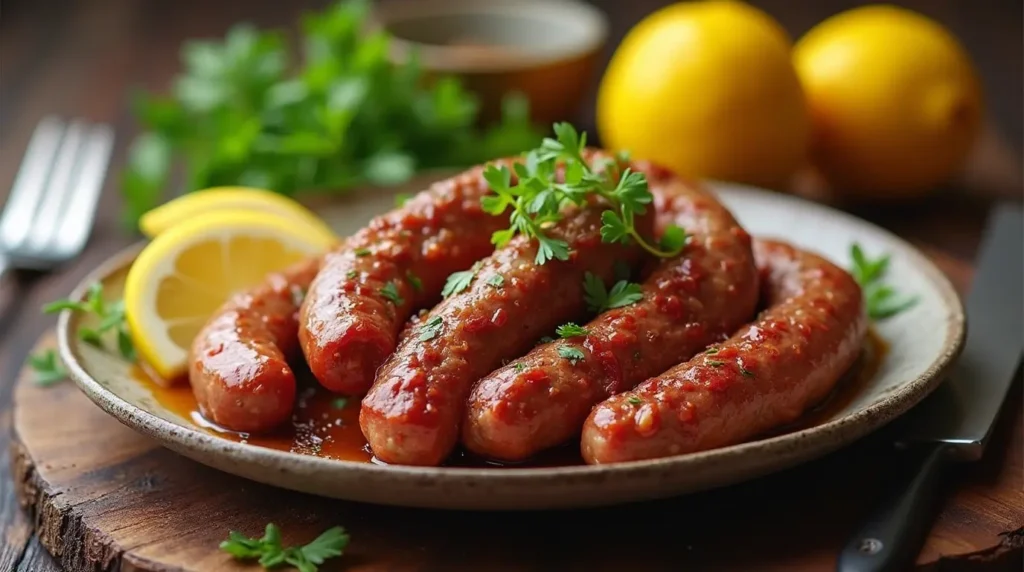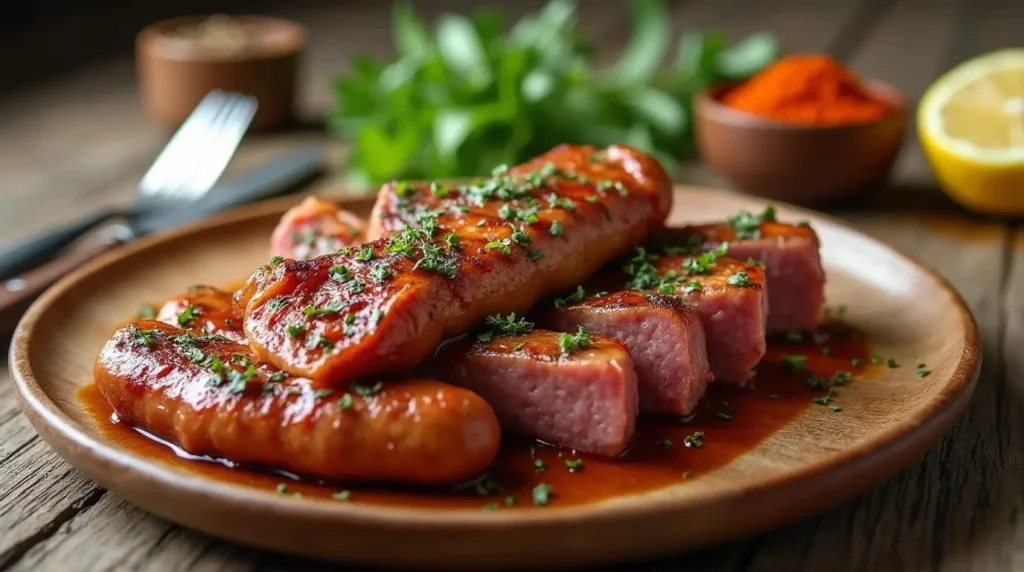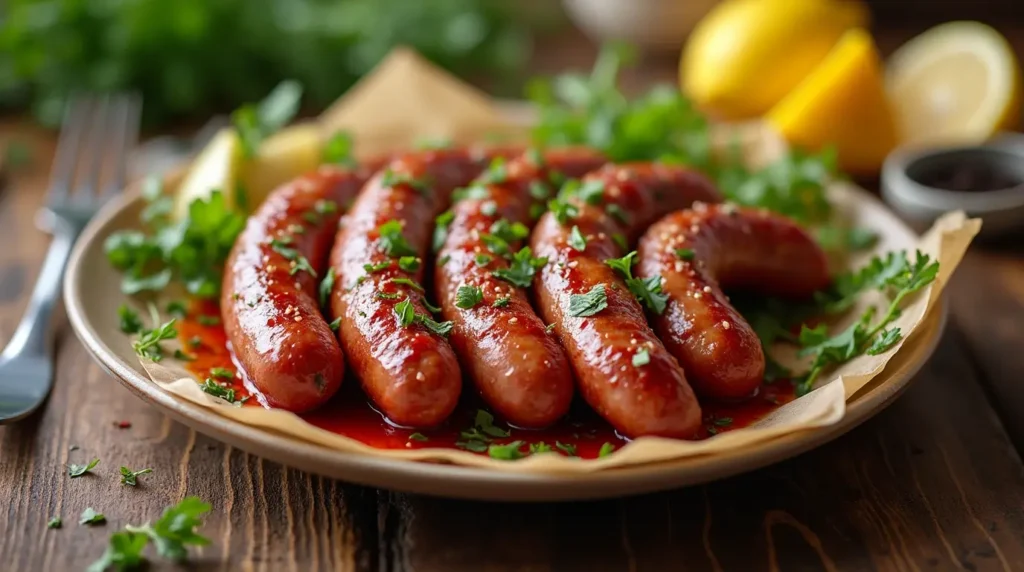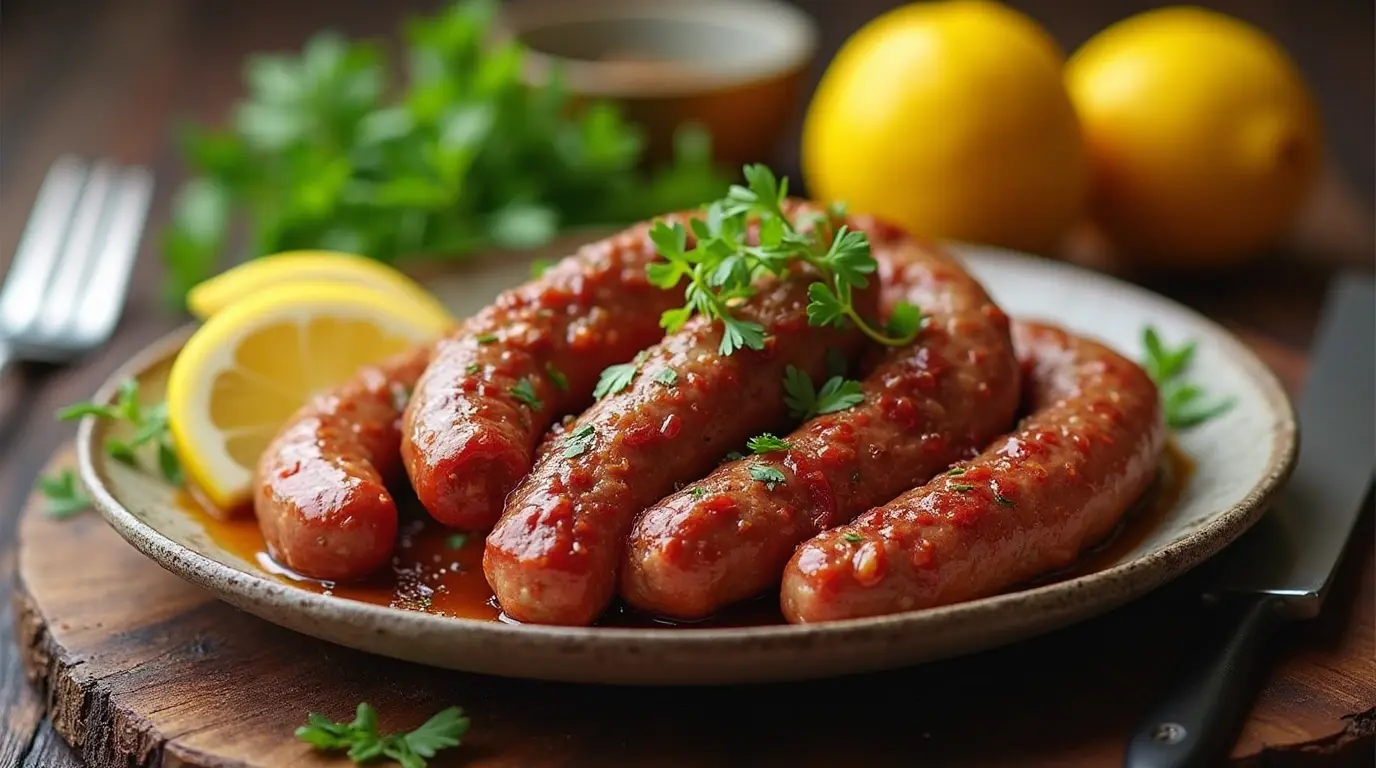There’s something incredibly satisfying about preparing a meal from scratch, and when it comes to sausages, nothing beats the flavor and freshness of homemade beef sausage. Whether you’re grilling it on a summer afternoon or adding it to your favorite pasta dish, the taste of homemade beef sausage is rich, juicy, and full of depth. If you’ve ever been intimidated by making sausages yourself, rest assured—it’s much easier than you might think. In this guide, we’ll walk you through an easy beef sausage recipe that anyone can master, even if you’ve never cooked sausages before!

Table of Contents
Simplicity Meets Flavor: Why This Recipe Works
If you’ve ever bought store-bought sausages, you might have noticed the long list of preservatives, fillers, and artificial flavorings on the label. While convenient, they often lack the rich, authentic taste that homemade sausages provide. That’s where this easy beef sausage recipe shines! By making it yourself, you control the quality of ingredients, ensuring a fresh, preservative-free, and flavorful sausage that’s perfect for any meal.
Why Choose Homemade Beef Sausage?
There are several reasons why this recipe is a must-try, whether you’re a beginner in the kitchen or a seasoned cook looking for a foolproof sausage-making method.
1. Control Over Ingredients
One of the biggest advantages of making homemade beef sausage is knowing exactly what goes into it. Unlike store-bought versions, which may contain preservatives, excessive sodium, and artificial flavors, this recipe uses fresh, high-quality ingredients. You can also adjust the seasonings to suit your taste—whether you prefer a milder sausage or one with a spicy kick.
- No artificial preservatives or additives – just pure, wholesome ingredients.
- Customize the flavors – tweak the spice level to your liking.
- Choose high-quality beef – opt for organic or grass-fed beef for a richer taste.
2. Simple and Beginner-Friendly Recipe
If you’ve never made sausages before, don’t worry—this recipe is designed to be straightforward and stress-free. With just a handful of common ingredients and a few simple steps, you’ll have delicious beef sausages ready in no time. Plus, you don’t even need a sausage stuffer—if you don’t have casings, you can shape the mixture into patties or loose ground sausage instead.
- Minimal ingredients, maximum flavor.
- No special equipment needed.
- Takes less than 30 minutes to prepare.
3. Packed with Bold, Delicious Flavor
What sets this beef sausage recipe apart is its perfect balance of spices. A blend of garlic powder, onion powder, black pepper, and paprika enhances the natural richness of the beef, giving the sausage a robust, savory taste. Whether you grill it, pan-fry it, or bake it, the result is a juicy, flavorful sausage that pairs well with a variety of dishes.
- Perfectly seasoned with aromatic spices.
- Works great in breakfast, lunch, or dinner recipes.
- Pairs well with eggs, pasta, sandwiches, and more.
The Building Blocks of a Perfect Beef Sausage
Creating the perfect beef sausage starts with selecting the right ingredients. The beauty of homemade sausage is that you can customize it to your exact preferences, using fresh, high-quality ingredients to bring out the best flavors. Whether you’re aiming for a more traditional flavor profile or looking to experiment with your own spice blend, the foundation of any great sausage is its core ingredients.
Breaking Down the Ingredients
Each ingredient in this recipe plays a key role in achieving the right balance of texture, flavor, and juiciness. Here’s a detailed look at the ingredients that make up the perfect beef sausage:
Beef Sausage Ingredient Table:
| Ingredient | Quantity | Notes |
|---|---|---|
| Ground beef | 2 pounds | Preferably with 80% lean to 20% fat ratio for a good balance of flavor and juiciness. This fat ratio ensures the sausage remains tender and flavorful without being too greasy. |
| Pork fat (optional) | 1/2 pound | Adds moisture and richness to the sausage, helping to keep it juicy. If you prefer a leaner sausage, you can skip this, but it will affect the sausage’s texture. |
| Garlic powder | 1 teaspoon | Provides a savory, aromatic base. Garlic powder is a classic seasoning that complements beef beautifully and enhances the sausage’s overall flavor profile. |
| Onion powder | 1 teaspoon | Adds depth and a mild sweetness that balances out the savory garlic. Onion powder is perfect for bringing warmth to the sausage without being overpowering. |
| Paprika | 1 teaspoon | Brings color and mild spice to the sausage. Paprika also adds a slight smokiness, depending on whether you use sweet or smoked paprika, enhancing the sausage’s complexity. |
| Salt | 1 1/2 teaspoons | Essential for bringing out all the flavors in the sausage. Adjust the amount based on personal preference, but don’t skimp on the salt—it helps bind the sausage together and amplifies the taste. |
| Black pepper | 1 teaspoon | Freshly ground black pepper adds a sharp bite and enhances the other seasonings. Freshly ground pepper is ideal for better flavor than pre-ground varieties. |
| Crushed red pepper | 1/2 teaspoon | Optional, but perfect for those who enjoy a little heat. Crushed red pepper flakes give the sausage a subtle kick without overwhelming the other spices. |
| Fresh parsley | 2 tablespoons | Chopped, for a burst of freshness and color. Fresh parsley adds a herbaceous note to the sausage, balancing out the richness of the beef and fat. |
| Ice water | 1/4 cup | Helps in binding the sausage mixture together. Adding ice water gradually while mixing ensures a smooth, cohesive texture and prevents the fat from separating. |
Why These Ingredients Matter
- Ground beef: The meat choice is crucial in beef sausage. Opting for a blend with 80% lean to 20% fat ensures that the sausage is juicy without being greasy. The right fat content helps maintain a smooth texture while ensuring it doesn’t dry out during cooking.
- Pork fat: While pork fat isn’t mandatory, it enhances the texture and flavor of the sausage by adding moisture and richness. If you want a more traditional or indulgent sausage, pork fat is an excellent choice, but for a leaner version, feel free to omit it.
- Spices: The combination of garlic powder, onion powder, and paprika forms the aromatic base that makes this sausage truly savory. These ingredients bring balance—garlic and onion for depth and paprika for color and mild smokiness. Black pepper and crushed red pepper add the perfect amount of spice, while parsley gives the sausage a fresh and vibrant finish.
- Ice water: The role of ice water is often overlooked, but it’s essential for the sausage’s texture. Adding it slowly while mixing helps bind the ingredients together, ensuring the sausage holds its shape when cooked. It also prevents the fat from becoming greasy and separates properly.
Customizing Your Beef Sausage
Once you’ve mastered the basic ingredients, you can adjust the recipe to fit your preferences or explore different flavor profiles. If you prefer a more herby sausage, try adding thyme, rosemary, or sage. For a bolder taste, consider adding smoked paprika or a dash of cayenne pepper for extra heat.
By understanding the role each ingredient plays, you can confidently experiment with your easy beef sausage recipe to create sausages that suit your exact taste preferences. Whether you stick to the classic version or make it your own, the building blocks for a delicious homemade beef sausage remain the same!

How to Make Homemade Beef Sausage
Making homemade beef sausage can seem like a daunting task, but once you break it down step by step, you’ll find it’s not as difficult as it seems! Whether you’re a beginner or an experienced cook, this simple beef sausage recipe will guide you through the process of crafting your own delicious sausages from scratch. Let’s walk through the essential steps for creating the perfect homemade beef sausage.
1. Prepare the Meat and Fat
Key Points:
- Grind the Beef and Pork Fat:
The first step in making beef sausage is preparing the meat. You’ll want to grind your beef and pork fat (if using) together to create a uniform texture. You can either use a meat grinder or a food processor to do this. For a coarse grind, use a larger plate or blade on your grinder to ensure the sausage has a nice, hearty texture.Tip: If you don’t have a meat grinder, don’t worry! Simply ask your butcher to grind the beef for you. They can grind it to the coarseness you desire and even add the right amount of pork fat to achieve the perfect texture.- Pro Tip: For an even better texture, you can chill the meat and fat in the freezer for about 30 minutes before grinding. This helps the fat stay firm, which results in a smoother, more cohesive sausage mixture.
2. Add the Spices and Seasonings
Key Points:
- Combine the Ground Beef and Spices:
Now that your meat and fat are ground, it’s time to season the mixture. In a large mixing bowl, add your ground beef and any additional pork fat you’re using. Then, add the spices: garlic powder, onion powder, paprika, black pepper, crushed red pepper (if you want a spicy kick), and salt. Sprinkle the fresh parsley in as well, for an extra burst of flavor and color. - Mix Everything Well:
Use your hands or a sturdy spoon to mix the meat and seasonings together. It’s essential that the spices are evenly distributed throughout the sausage mix to ensure each bite has the perfect balance of flavor. Don’t be afraid to get your hands in there and really knead the mixture until it’s uniform.Tip: Be gentle when mixing to avoid overworking the meat. Overmixing can cause the sausage to become dense and tough, so mix just until everything is well-combined.
3. Incorporate Ice Water
Key Points:
- Add the Ice Water Gradually:
Once your spices are mixed in, it’s time to add the ice water. This step is crucial for binding the sausage together and achieving the right texture. Gradually add the cold water to the meat mixture while continuing to mix. Add a little bit at a time to ensure the mixture is absorbed fully before adding more. - Mix Until Tacky:
As you mix, you’ll notice the sausage mixture becoming sticky and slightly tacky. This is a good sign! It means the meat is binding properly and will hold together well during cooking. The ice water helps to emulsify the fat and meat, creating a smooth and cohesive texture.Tip: If the sausage mixture feels too dry and crumbly, you can add a little more ice water until it reaches the perfect consistency. But don’t add too much at once—keep it gradual.
4. Stuff the Sausage (Optional)
Key Points:
- Stuffing the Sausage:
If you’re planning to use sausage casings, this is where the fun begins! Stuffing the sausage into casings gives it that classic sausage shape. To do this, you’ll need to carefully stuff the sausage mixture into the casings, making sure not to overstuff. The goal is to pack the mixture tightly, but leave a little room so the sausages can expand during cooking without bursting.- Twist the Sausage Links:
Once your sausage casings are filled, twist them into links about 6 inches long, and tie off the ends securely with kitchen twine. You can also use a small piece of string to tie the sausage at intervals, ensuring each link stays intact.
- Twist the Sausage Links:
5. Rest the Sausages
Key Points:
- Rest the Sausages Before Cooking:
Once your sausages are stuffed or shaped into patties, it’s important to let them rest in the fridge for at least 1 hour before cooking. This resting period allows the flavors to meld and the sausage to firm up, making it easier to cook evenly. If you’re using casings, resting also helps the sausage maintain its shape.- Why Resting Matters:
Resting gives the sausage time to set, and the flavors have a chance to fully develop. It also helps the sausage hold together better when cooking, preventing it from falling apart on the grill or in the pan.
- Why Resting Matters:

A Few Final Tips Before Cooking
- If you’re cooking beef sausages right away, make sure to check the internal temperature with a meat thermometer. Sausages should reach 160°F (71°C) to be safe for consumption.
- Whether you’re grilling, frying, or baking, make sure to cook your sausages until they are fully browned and cooked through.
By following these simple steps, you can easily craft your own homemade beef sausage that’s bursting with flavor and perfect for any meal. Whether you choose to stuff them in casings or make patties, the key is using fresh ingredients and taking your time to perfect the mixture. Enjoy the process, and get ready to savor the delicious results!
Delicious Dishes to Pair with Beef Sausage
Once you’ve made your easy beef sausage, the possibilities for delicious meals are endless! Beef sausage has a rich, savory flavor that pairs beautifully with a variety of side dishes, sauces, and even in hearty meals. Here are some great ways to enjoy your homemade sausages, whether you’re looking for a quick snack or a full meal.
1. Serve with Mashed Potatoes and Grilled Vegetables
One of the classic ways to enjoy beef sausage is by pairing it with mashed potatoes and grilled vegetables. The creamy, buttery mashed potatoes complement the savory, juicy sausage, while the grilled vegetables add a burst of freshness and lightness to balance the richness.
How to Serve:
- Grilled Vegetables: Choose a variety of vegetables like zucchini, bell peppers, onions, and mushrooms. Toss them with a little olive oil, salt, and pepper before grilling or roasting.
- Mashed Potatoes: Make creamy mashed potatoes with butter, cream, and garlic for an extra layer of flavor. You can even add herbs like rosemary or thyme for a more aromatic touch.
2. Add to Pasta Dishes
Beef sausage can elevate any pasta dish by adding a burst of flavor and texture. Whether you’re making a rich tomato-based sauce or a creamy white sauce, sausages can take it to the next level.
How to Serve:
- Sausage and Tomato Pasta: Slice your cooked sausages into bite-sized pieces and add them to your favorite pasta sauce, like marinara or bolognese. Toss with pasta and top with fresh basil or Parmesan cheese.
- Creamy Sausage Pasta: For a decadent meal, try adding sausages to a creamy pasta dish with Alfredo sauce. The richness of the sausage complements the creamy sauce perfectly.
3. Make a Flavor-Packed Casserole
Casseroles are a great way to turn beef sausages into a hearty, filling meal. You can add sausages to potato casseroles, vegetable casseroles, or even pasta-based casseroles. The sausages will infuse the dish with flavor as it bakes, making for a comforting meal.
How to Serve:
- Sausage and Potato Casserole: Layer slices of cooked sausages with thinly sliced potatoes, onions, and cheese. Add a creamy sauce or broth, then bake until golden and bubbly.
- Sausage and Vegetable Casserole: Combine beef sausages with a mix of roasted or steamed vegetables (like carrots, green beans, and sweet potatoes), then top with breadcrumbs and cheese for a crispy finish.
4. Enjoy on Pizza
If you’re looking for a fun and easy way to enjoy beef sausage, try adding it to a homemade pizza. The bold flavor of the sausage pairs wonderfully with the tangy tomato sauce, gooey cheese, and your favorite pizza toppings.
How to Serve:
- Sausage and Mushroom Pizza: Top your pizza dough with tomato sauce, mozzarella cheese, sliced beef sausages, and mushrooms for an earthy, hearty combination.
- Sausage and Peppers Pizza: Pair the sausages with sautéed bell peppers and onions for a flavorful, Italian-inspired pizza.
5. Casual Snack: Sausage in a Bun with Sautéed Onions
For a more casual meal or a quick snack, beef sausages in a bun with sautéed onions and mustard can’t be beaten. This easy-to-make dish is perfect for a busy weeknight or a satisfying lunch.
How to Serve:
- Sautéed Onions: Thinly slice onions and sauté them in butter or oil until they’re soft and caramelized. You can even add a little balsamic vinegar for extra flavor.
- Buns and Mustard: Place the sausages in soft buns and top with the caramelized onions, mustard, and perhaps a little cheese. For a spicier twist, add a drizzle of hot sauce or relish.
Proper Storage Tips for Beef Sausage
If you’ve made a big batch of homemade beef sausages or simply have leftovers, knowing how to store them properly ensures they stay fresh and safe to eat for longer. Here are some essential storage tips for both cooked and uncooked sausages.
Refrigeration: Storing Cooked or Uncooked Sausages
Both cooked and uncooked beef sausages should be stored properly to maintain their quality and safety. Here’s how to store them in the fridge:
Key Points:
- Cooked Sausages: Once your sausages are cooked, allow them to cool to room temperature before storing. Place them in an airtight container or wrap them tightly with plastic wrap or aluminum foil. Stored in the fridge, they will stay fresh for 3-4 days.
- Uncooked Sausages: If you have leftover uncooked sausages, make sure to store them in the fridge as well, in an airtight container or tightly wrapped in plastic wrap. They will last for 2-3 days in the refrigerator before needing to be cooked.
Freezing: Store Sausages for Longer Use
Freezing your beef sausages is a great way to preserve them for a longer period. Whether uncooked or cooked, freezing helps maintain freshness and flavor until you’re ready to enjoy them again.
Key Points:
- Uncooked Sausages: To store uncooked sausages in the freezer, wrap each sausage tightly in plastic wrap to prevent freezer burn. Then, place them in a freezer-safe bag or an airtight container. Uncooked sausages will stay fresh in the freezer for up to 3 months.
- Cooked Sausages: You can also freeze cooked sausages in a similar manner. Once they’ve cooled, wrap them in plastic wrap and place them in a freezer-safe bag or container. Cooked sausages can be stored in the freezer for up to 2 months.
Thawing Tips:
- For both cooked and uncooked sausages, the best way to thaw them is by placing them in the fridge overnight. If you need them sooner, you can defrost them in the microwave or cook them directly from frozen, though cooking times will be longer.
By knowing how to store your beef sausages properly, you can enjoy them over several meals without worrying about them going bad. Whether you’re saving leftovers for later or stocking up for future meals, proper storage ensures that you’ll have delicious sausages ready to cook whenever you need them!
Frequently Asked Questions (FAQ)
H2: Common Questions About Easy Beef Sausage
1. Can I make beef sausage without casings?
- Yes, you can simply form sausage patties or cook the mixture loose in a pan.
2. How do I know when my beef sausage is cooked?
- Use a meat thermometer to ensure the internal temperature reaches 160°F (71°C).
3. Can I substitute ground pork in this recipe?
- Absolutely! Ground pork or even chicken can work as an alternative to beef.
4. How long should I rest the sausage mixture before cooking?
- Rest the sausages in the fridge for at least 1 hour to allow the flavors to meld and the sausages to firm up.
Conclusion: Savor the Simplicity of Homemade Beef Sausage
Making your own easy beef sausage isn’t just about crafting a delicious dish; it’s about taking control of the ingredients and the flavors you love. With this simple recipe, you can enjoy fresh, flavorful sausages that are perfect for any meal. Whether you’re grilling, frying, or baking, these sausages will impress every time. Try making your own beef sausage today, and savor the satisfaction of a homemade dish that’s as easy as it is delicious.


2 thoughts on “Easy Beef Sausage Recipe A Flavorful Simple”